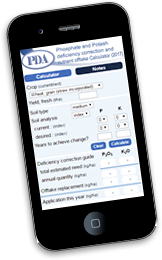PDA News
The PDA publishes both technical News items and shorter Blog items. PDA News provides the latest up to date information on macronutrients and their use, while blog items are shorter and timelier.
If you are in the UK or Ireland and are interested in receiving PDA News items through the post or by email free of charge, then sign up on the contact page. Recipients can receive CPD points for BASIS and NRoSO.
Potassium for the soil and crop: the importance of getting it right
May 2019
Patrick J. Forrestal1, Mark Plunkett1, Cathal Redmond1 and Martin Bourke21Soils, Land Use and Environment Dept. Teagasc, Johnstown Castle, Co. Wexford.2Teagasc Advisory Service, Tinnahealy, Co. Wicklow Introduction Crops including spring barley require high levels of potassium (K) to support yield, often at similar levels to nitrogen (N). Potassium has traditionally received much less focus compared with […]
Understanding phosphate
February 2019
I have recently seen two statements that imply that using water-soluble phosphate fertilisers increases the risk of loss of phosphate to surface water, with its adverse environmental implications, and that the majority of the phosphate applied to soil becomes fixed in the soil and is unavailable to plants. Neither statement is true..
Potash use on grass
October 2018
It has been well known for decades that grass can take up and, if cut for silage or hay remove from the field, very large amounts of potash. Typical potash removal values shown in the Nutrient Management Guide (RB209) are equivalent to around 2% K in dry-matter, sometimes higher in fresh grass and lower in […]
Nitrogen & potassium Interactions
April 2018
Justus von Liebig’s Law of the Minimum states that yield is proportional to the amount of the most limiting nutrient, whichever nutrient it may be (Figure 1). Nitrogen is the nutrient that most frequently provides the largest response, suggesting that this is usually most limiting. However, the plant available potassium status of a soil has […]
Magnesium as a nutrient for crops and grass
December 2017
Dr Ian Richards, Independent Consultant, Ecopt. Introduction The 13 or so essential nutrients for plants are grouped, in fertiliser regulations, into primary nutrients (nitrogen, phosphate and potash), secondary nutrients (calcium, magnesium, sulphur and sodium) and micronutrients (manganese, copper, boron etc) according roughly to the amounts needed by crops. Don’t be deceived by the term ‘secondary’; […]
Sulphur as a nutrient for crops and grass
September 2017
Introduction Sulphur is an essential nutrient for all plants, and certain crops are more vulnerable to deficiency than others. Historically, in the UK sulphur was deposited on land from the atmosphere in quantities which were adequate for our crops. However, as the burning of UK coal (high S) in power stations was switched to imported […]
AHDB Nutrient Management Guide (RB209)
June 2017
AHDB have just launched their new Nutrient Management Guide (RB209). It is a revision of the Defra Fertiliser Manual (RB209) and it can be viewed or downloaded to your computer from their website www.ahdb.org.uk/rb209. Also, there is an App for mobile devices. Hard copies can be requested by e mail to cereals.publications@ahdb.org.uk. It is supplied free […]
Low soil P & K indices – Do they matter? Yes!
March 2017
The British Survey of Fertiliser Practice (Defra) shows that since the 1980s rates of Phosphate & Potash fertiliser applications have declined by 1/3 in arable crops, and 2/3 in grassland. With the increase in yields achieved in that time, there is a serious deficit in the P & K being applied from fertilisers, which is […]
Forage maize – phosphate & potash offtakes
December 2016
With the huge increase in growing forage maize to feed anaerobic digesters, especially in the arable areas of Eastern England, it seems appropriate to consider the harvested offtakes of phosphate and, especially, the high amounts of potash removed.
Soil sampling and different methods of arable cultivation
December 2016
Soil sampling for the routine measurement of P, K, Mg indices and pH is familiar to most advisers and farmers, with the same well-proven method used for many years. But how are things different where minimum cultivation is practised?
Crop nutrition assignment by Melissa Gorst of Newcastle University
August 2016
This year we sponsored the Crop Nutrition essay at Newcastle University and Melissa Gorst, a 2nd year agricultural degree student, won our prize with this essay.
Optimising potash use on cut grassland
April 2016
Grass cut regularly, as silage, haylage or hay, removes very large amounts of potassium (K). Unless this is replaced, soil K concentrations will fall. In recent years there is evidence of an overall increase in the number of grassland soils below target index (2-), as well as a decline in the use of potash fertiliser. This situation is not sustainable and grass yields will fall unless corrected.

